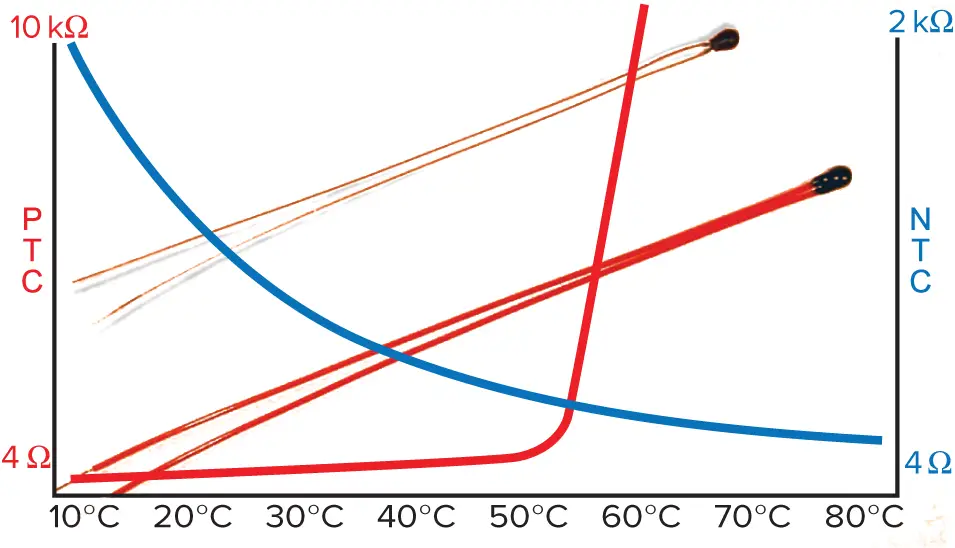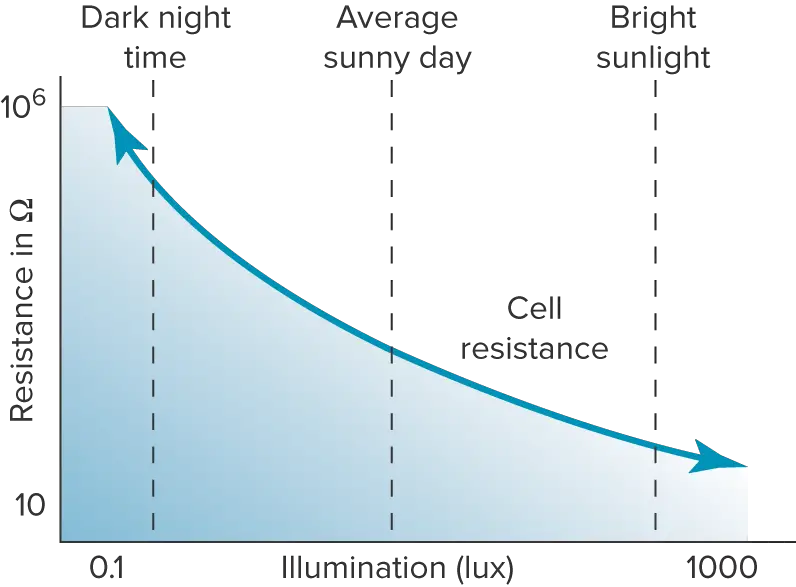The article covers various special-purpose resistor types, including thermistors, voltage-dependent resistors (VDRs), light-dependent resistors (LDRs), and non-inductive resistors, each serving specific functions based on their unique characteristics, such as temperature or light sensitivity.
Non-ohmic (non-linear) resistors exist that change resistance according to other physical parameters such as voltage, temperature, and ambient light. These resistors are useful as sensors in instrumentation and, when used as a sensor, are known as ‘transducers.’
Thermistors
A thermistor is a type of resistor whose resistance value varies with small changes in temperature. (The word ‘thermistor’ is derived from the combination of ‘thermal’ and ‘resistor’.)
Thermistors can be grouped into two types based on how their resistance value changes in response to temperature.
Negative Temperature Coefficient (NTC) Thermistors
The resistance value of NTC thermistors decreases with an increase in temperature. Therefore, the current flowing through an NTC thermistor will increase with an increase in temperature. The IEC standard symbol for NTC thermistors is shown in Figure 1.

Figure 1. IEC symbol for (a) an NTC thermistor and (b) a PTC thermistor
Positive temperature coefficient (PTC) thermistors
The resistance value of PTC thermistors increases with an increase in temperature. Therefore, the current flowing through a PTC thermistor will decrease with an increase in temperature.
Thermistors are used for:
- motor winding protection
- hot ends of 3D printers
- home appliances such as ovens, hair dryers, toasters and refrigerators
- computers
- temperature sensors.
Figure 2 shows the typical characteristics of NTC (blue) and PTC (red) thermistors. Usually, the resistance values are shown on a logarithmic scale, but in order to illustrate the sharp ‘knee’ of the curve as the PTC heats up, a representative curve has been drawn from test results on actual thermistors. The resistance of the PTC thermistor is only 4 Ω at room temperature but rises rapidly once the temperature goes above around 50°C. The NTC thermistor, on the other hand, has a high resistance at low temperatures and drops in a non-linear fashion as temperature rises.

Figure 2 Typical thermistor characteristics curves
Low-Temperature Coefficient Resistors
In some circumstances, a resistor is required to retain its value over a range of temperatures. An ideal material in such circumstances is manganin, which has a temperature coefficient of resistance given as 0.00001(10−5). Its resistance change is generally so small compared with other metallic elements that it is often listed as zero. Manganin is used where resistors of high-temperature stability are required, for instance, in measuring instruments.
Voltage-Dependent Resistors (VDRs)
A voltage-dependent resistor (VDR) or varistor is a component that has its resistance varied with the applied voltage. VDRs are manufactured from a mixture of materials to have a very high resistance at lower voltages but a very low resistance above a certain critical value. A VDR is usually presented in disc form, with two leads for connection into a circuit, as shown in Figure 3.

Figure 3. Voltage-dependent resistors (VDRs) Diagram
The VDR is connected in parallel with the voltage supply, close to the circuit it must protect. Usually, it does not conduct, but when the supply voltage exceeds a designed limit, it breaks down and conducts the excess energy away from the circuit it is protecting. Modern VDRs are constructed using sintered ceramic metal-oxide materials and are commonly known as metal-oxide varistors (MOVs). Figure 4 shows how a VDR’s resistance varies with applied voltage.

Figure 4. VDR’s response to applied voltage graph
The primary purpose of a VDR is to protect equipment against voltage surges such as lightning strikes. The response time is extremely quick—an obviously necessary characteristic.
In some circuits, VDRs are intended to blow a fuse or trip a circuit breaker to isolate the electric circuit being protected. Sometimes a VDR is built into a package called a ‘surge protector,’ which can be installed in the main switchboard or on the consumer’s terminals. Depending on the individual device and the severity of the surge, a VDR might have to be replaced after it has operated.
The IEC standard symbol for a voltage-dependent resistor is shown in Figure 5.

Figure 5. IEC symbol for a voltage-dependent resistor
Light-Dependent Resistors (LDRs)
Light-dependent resistors (LDRs) are used to detect light levels, such as in PE (photo-electric) cells on power poles, to turn streetlights on and off, or to control other night lighting. When light falls on the resistor, the resistance changes and an electronic circuit sense changes to turn a relay or solid-state switch on or off. Figure 6 shows the relationship between resistance and illumination in an LDR.

Figure 6. Resistance and illumination graph in an LDR
Light-dependent resistors are usually made from cadmium-sulfide film mounted on a ceramic or phenolic plate and covered with a conductive grid. To ensure there is no build-up of contamination and to protect the active material, the resistor is mounted in an evacuated glass envelope or covered with a clear plastic encapsulation. Figure 7 shows a variety of LDRs.

Figure 7.Light-dependent resistors Diagram
Figure 8 shows the IEC standard symbol for a light-dependent resistor.

Figure 8. IEC symbol for a light-dependent resistor
The resistance of the device varies considerably with the amount of light received on the surface. Typically, the resistance in complete darkness can be as high as 10 MΩ, reducing to possibly 100 Ω in sunlight.
Non-Inductive Resistors
A critical point to keep in mind when designing switching or high-frequency circuits is that the construction of most resistors is similar to that of inductors, i.e. they contain a length of wire wound like a coil around a ceramic former. This means that resistors may add unwanted inductance to a circuit. To avoid inductance and make the resistor as purely resistive as possible, the wire-wound resistor is wound back on itself, which has the effect of canceling out any inductance produced. This type of wound resistor is also called a ‘bifilar resistor,’ the construction of which is shown in Figure 9.

Figure 9. Bifilar resistor construction diagram
Liquid Resistors
Resistances for motor starters use a resistive liquid which is stored in a tank, with two electrodes conducting the power to it. The resistance is free to cool through convection and conduction through the tank surface, so the tank size can be designed to suit the required dissipation.
One advantage of liquid resistance is that the resistance value decreases as the temperature rises (exhibiting a negative temperature coefficient or NTC), which is useful for motor starters. Figure 10 shows a liquid resistance wound rotor induction motor starter.

Figure 10. Liquid resistance rotor starter Diagram
Special Purpose Resistors FAQs
- What is a thermistor?
A thermistor is a type of resistor whose resistance value varies with small changes in temperature.
- What is the difference between an NTC and a PTC thermistor?
The resistance value of NTC thermistors decreases with an increase in temperature.
The resistance value of PTC thermistors increases with an increase in temperature.
- What is an MOV, and what is it commonly used for?
A metal-oxide varistor (MOV) is a voltage-dependent resistor and is used in surge protectors.
- How does resistance in an LDR change in response to light?
When light falls on the resistor, the resistance decreases, and an electronic circuit sense changes to turn a relay or solid-state switch on or off.
- How can resistor design remove unwanted inductance?
To avoid inductance and to make the resistor as purely resistive as possible, the wire-wound resistor is wound back on itself, which has the effect of canceling out any inductance produced.
Special-Purpose Resistors Key Takeaways
Special-purpose resistors play a crucial role in various electronic applications due to their unique characteristics and functionalities. Thermistors are essential for temperature sensing in devices like motor windings and home appliances. Voltage-dependent resistors (VDRs) safeguard equipment against voltage surges, while light-dependent resistors (LDRs) are pivotal in light detection systems for automation and control. Additionally, non-inductive resistors and liquid resistors offer solutions for reducing unwanted inductance and controlling motor starters, respectively. Understanding the diverse applications and functionalities of these special-purpose resistors is vital for engineers and designers to develop efficient and reliable electronic systems.